Some general weather trends can be gleaned from lunation charts and the Solar Ingress chart. Here we'll quickly go over the four lunation charts for August. These include the New Moon, Full Moon, First Quarter, and Last Quarter charts or maps.
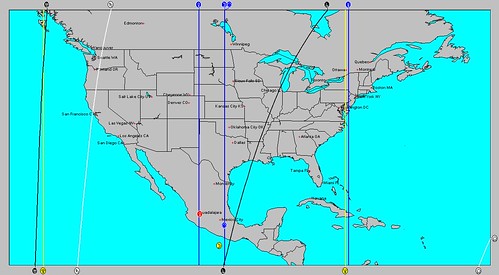
The first map above is the New Moon of July 30, 2011, which will be in effect for all of August until the 28th.
The New Moon in Leo occupies the the 98th degree of west longitude through the central Plains and Texas. This is a hot, dry influence. The New Moon is square Jupiter, which also indicates warmth but can bring atmospheric disturbances. Let's hope this means some rain for Texas and the surrounding area. Jupiter influences the Mississippi Valley in this regard.
Venus is also in Leo through the Front Range and Plains. Venus usually increases atmospheric moisture so along with the heat symbolized by Leo we might get some precipitation during the month of August. The 1st through the 4th is a period when there could be some action along these lines.
The Northeast is under the influence of the Mercury-Neptune opposition. This increases temperatures and humidity leading to low pressure areas and rain through out the month of August. Since Mercury will go retrograde on August 2nd and then oppose Neptune on the 8th strong storms are possible with lots of moisture. This has been mentioned in another post for August 9-13.
Saturn affects the West Coast states of Washington, Oregon, and northern California arguing for cooler conditions and some precipitation. It's interesting to note that Accuweather just posted an article entitled Northwest Continues to Chill This Summer. With Saturn in this position, cool weather seems likely to continue for the region during August, which is their conclusion as well. There are two stormy periods indicated for the West Coast states in the Solar Ingress around the 16th when coastal regions of northern California and the Pacific Northwest could see a strong front pushing inland and around 21st when monsoonal moisture might trigger storms in the desert Southwest.
Uranus and Pluto are off the West Coast at 132 west longitude calling for cooler conditions and a possible low pressure system or front around August 9-11.
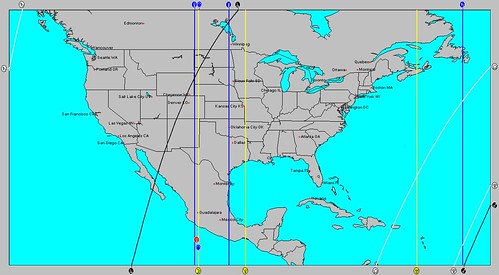
Full Moon August 13, 2011
This Full Moon heavily bombards the Plains. The Sun, Moon, Venus, and Jupiter concentrate their influence over the Dakotas, eastern Montana, and eastern Wyoming. While all these indicate heat, Venus does increase moisture. One possibility is that this area will periodically be subject to increasing temperatures and storm systems--for example around the 20th and 21st.
The triple conjunction of the Sun, Mercury, and Venus around the 16th will also strongly affect the Plains with a heat wave, but I'm hoping the heat will provoke thunderstorms and rain. I've mentioned extreme southern Texas in this regard in another post.
Mercury and Neptune also affect the Plains. While Mercury retrograde can signify high pressure and wind (something we don't need over the southern Plains right now), Neptune is associated with humidity and rain. Neptune's position along the 94th degree of west longitude affects the eastern Plains and signifies atypical rainfall during this Full Moon period. We may get some good rain around the 21st and 22nd as moisture is pull up out of the Gulf of Mexico and drawn northward over the Arklatex region.
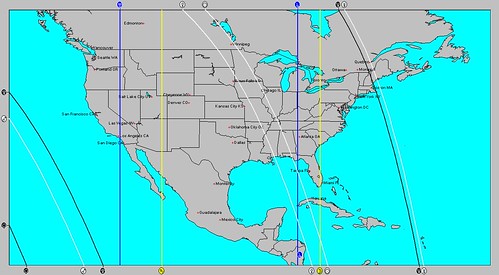
First Quarter Moon August 6, 2011
Uranus and Saturn affect the western states and the Rockies exercising a cooler influence. The rain-making Mercury-Neptune pair resides over the New England area extending the same influence in the New Moon chart farther eastward.
This chart indicates some possible tropical activity in the eastern Gulf off the west Florida coast around August 12th and 13th and in the central Caribbean around the same time.
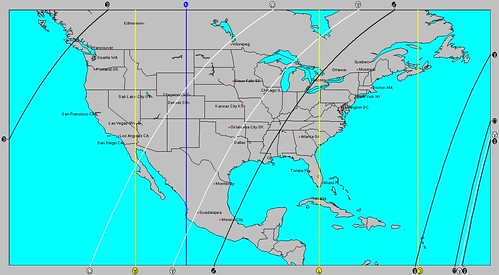
Third Quarter Moon August 21, 2011
Uranus and Saturn also affect the western states and the Rockies indicating cooler conditions. Mars and Jupiter over the eastern Great Lakes indicate a stormy time especially around the 27th and 28th.

The first map above is the New Moon of July 30, 2011, which will be in effect for all of August until the 28th.
The New Moon in Leo occupies the the 98th degree of west longitude through the central Plains and Texas. This is a hot, dry influence. The New Moon is square Jupiter, which also indicates warmth but can bring atmospheric disturbances. Let's hope this means some rain for Texas and the surrounding area. Jupiter influences the Mississippi Valley in this regard.
Venus is also in Leo through the Front Range and Plains. Venus usually increases atmospheric moisture so along with the heat symbolized by Leo we might get some precipitation during the month of August. The 1st through the 4th is a period when there could be some action along these lines.
The Northeast is under the influence of the Mercury-Neptune opposition. This increases temperatures and humidity leading to low pressure areas and rain through out the month of August. Since Mercury will go retrograde on August 2nd and then oppose Neptune on the 8th strong storms are possible with lots of moisture. This has been mentioned in another post for August 9-13.
Saturn affects the West Coast states of Washington, Oregon, and northern California arguing for cooler conditions and some precipitation. It's interesting to note that Accuweather just posted an article entitled Northwest Continues to Chill This Summer. With Saturn in this position, cool weather seems likely to continue for the region during August, which is their conclusion as well. There are two stormy periods indicated for the West Coast states in the Solar Ingress around the 16th when coastal regions of northern California and the Pacific Northwest could see a strong front pushing inland and around 21st when monsoonal moisture might trigger storms in the desert Southwest.
Uranus and Pluto are off the West Coast at 132 west longitude calling for cooler conditions and a possible low pressure system or front around August 9-11.

Full Moon August 13, 2011
This Full Moon heavily bombards the Plains. The Sun, Moon, Venus, and Jupiter concentrate their influence over the Dakotas, eastern Montana, and eastern Wyoming. While all these indicate heat, Venus does increase moisture. One possibility is that this area will periodically be subject to increasing temperatures and storm systems--for example around the 20th and 21st.
The triple conjunction of the Sun, Mercury, and Venus around the 16th will also strongly affect the Plains with a heat wave, but I'm hoping the heat will provoke thunderstorms and rain. I've mentioned extreme southern Texas in this regard in another post.
Mercury and Neptune also affect the Plains. While Mercury retrograde can signify high pressure and wind (something we don't need over the southern Plains right now), Neptune is associated with humidity and rain. Neptune's position along the 94th degree of west longitude affects the eastern Plains and signifies atypical rainfall during this Full Moon period. We may get some good rain around the 21st and 22nd as moisture is pull up out of the Gulf of Mexico and drawn northward over the Arklatex region.

First Quarter Moon August 6, 2011
Uranus and Saturn affect the western states and the Rockies exercising a cooler influence. The rain-making Mercury-Neptune pair resides over the New England area extending the same influence in the New Moon chart farther eastward.
This chart indicates some possible tropical activity in the eastern Gulf off the west Florida coast around August 12th and 13th and in the central Caribbean around the same time.

Third Quarter Moon August 21, 2011
Uranus and Saturn also affect the western states and the Rockies indicating cooler conditions. Mars and Jupiter over the eastern Great Lakes indicate a stormy time especially around the 27th and 28th.
Texas Needs Tropical Storm Don
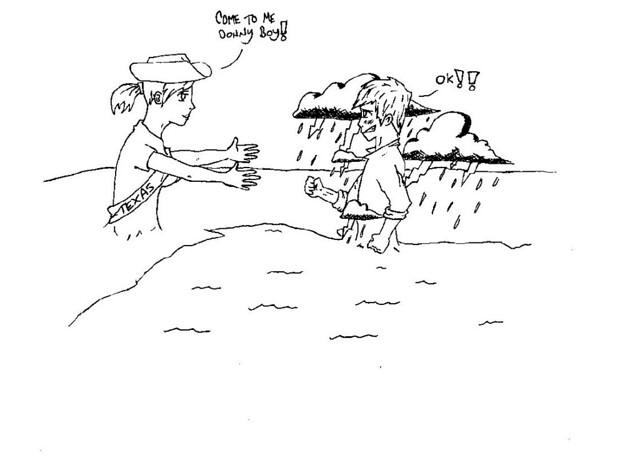
August 9-13, 2011 Long-range Forecast
August 16-18, 2011 Long-range Weather Forecast
Hurricane Beatriz Fulfills Long-range Weather Prediction!
Hurricane Season 2011 Baja, Mexico
Hurricane Risk-Management
Hurricane Season 2011 Predictions
Overview of UK Winter 2012-13
The Winters of 2011-14
Cyclone Yasi fulfills long-range prediction!
Tropical Storm Matthew Fulfills Long-range Forecast!
Hurricane Earl and T.D. 10E Fulfill Long-range Forecasts!
Tropical Storm Alex Fulfills Long-range Prediction!
Bonnie Fulfills Long-range Forecast!
Introduction to the Weather Alternative
How Long-Range Forecasts Are Made
Excerpts from Tidal Dynamics by Fergus J. Wood
4 comments:
This is VERY interesting and I am thouroughly impressed by the detail of these forecasts, although, as a meterologist I must ask if theres any theories as to why astronomical objects affect weather.
I am very interested in this topic, and will be checking back :)
Hi, Stormwolf!
Well, G.J. McCormack who was probably the 20th Century's best astro-meteorologist thought that the connection between astronomical objects and terrestrial weather was an electro-magnetic one.
Sort of like the photoelectric effect where light strikes a surface of a material and electrons come out. Perhaps the light from astronomical bodies affect particles in the atmosphere.
Cool! :D I will check the validity of these forecasts, and if you dont mind, I might feature some of your forecasts on my blog
Sure. Go right ahead. I also post the results of the forecasts afterwards.
Post a Comment